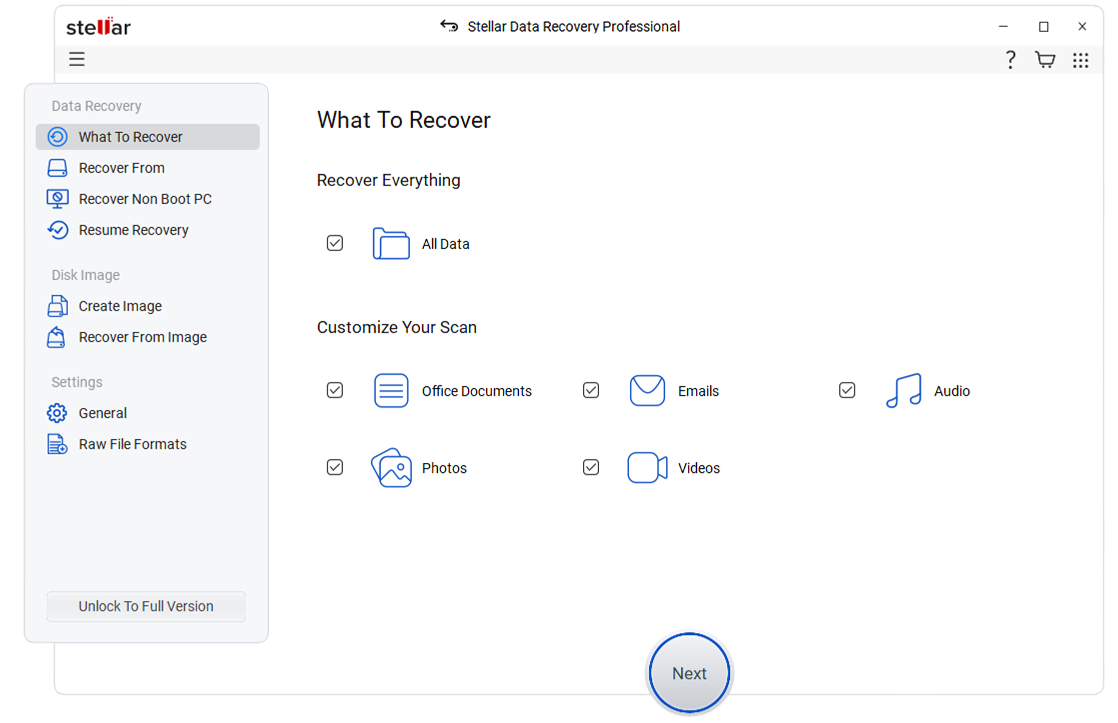Step 1 : Select Location

Select the type of data that you want to recover and click 'Next.'

Get your hands back on the accidentally or intentionally deleted files and folders quickly from Windows PCs, laptops, and hard drives.

No matter how and why you formatted your HDDs, SSDs, USBs or SD cards, you can still perform formatted hard drive recovery.

In a few clicks, recover your files lost permanently due to an emptied Recycle Bin with this professional data recovery software.

Regain your access to your drive's deleted or lost partitions using the ‘Can’t Find Drive’ feature of Stellar Data Recovery Professional software.

Clone your severely damaged hard drive to perform secure data recovery and prevent any further damage to the drive.

Create a recovery drive to boot into the crashed or non-booting Windows systems due to BSoD, or system errors and regain access to your data.

JPEG, JPG, PNG, TIFF, TIF, BMP, GIF, PSD, RAW, CRW, CR2, NEF, ORF, SR2, MRW, DCR , WMF, RGB, 3DM, 3DMF, 3FR, ABM, AFX, ANI, ART, ARW, BIZ, BLD, SWF, SVG , RAF, DNG, etc.

AVI, FLA, FLV, M4V, MOV, MP4, WMV, MKV, 3G2, 3GP, 3GP2, 3GPP, AMV, ANM, ASF, ASX, SWF, MPG, RM/RMVB, MPEG, etc.

DOC, DOCX, RTF, XLS, XLSX, XLSB, PPT, PPTX, PPS, PDF, CWK, HTML, HTM, INDD, EPS, DOT, DOTX, XLSB, XLT, XLTX, POT, PPSX, etc.

AIF/AIFF, M4A, MP3, WAV, WMA, MID/MIDI, OGG, AAC, Etc.

ZIP, RAR, ARJ, CAB, 7Z, LZA, RPM, TAR, BZ2, HQX, SIT, SITX, etc.

MSG, PST, OST, EML, EMLX, MBOX, EPUB, JIS, KEY, LOG, MPS, 3DA, 3DS, 3TF, 3WS, ABD, etc.
The high-tech data recovery tool can easily recover lost data from almost any
devices or storage media.
 PC/Mac
PC/Mac  Hard Disk/SSD
Hard Disk/SSD SD/Memory Card
SD/Memory Card USB
USB Digital Camera
Digital Camera Removable Drives
Removable Drives

* Free download to scan and preview your lost or deleted data.
0M+
Customers
0+
Years of Excellence
0+
R&D Engineers
0+
Countries
0+
Partners
0+
Awards Received
Technology You Can Trust Data Care Experts Since 1993
Stellar Data Recovery Inc.
10301 Northwest Freeway Suite 314,
Houston, Texas 77092-8227,
United States



